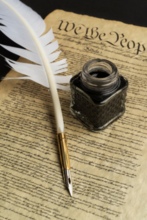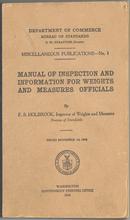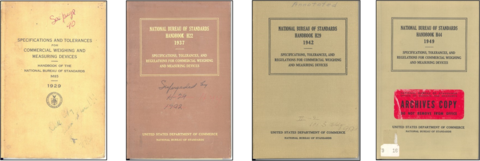The NIST Handbooks and NCWM: A Brief History

The U.S. Constitution (Article I, Section 8, Clause 5) grants Congress the power to “fix the standard of weights and measures”. The NIST Organic Act also authorizes NIST to engage in implementing activities to carry out this function, including “cooperat[ing] with the States in securing uniformity in weights and measures laws and methods of inspection” [15 U.S.C. § 272(c)(4)]. NIST’s statutory role to assure uniformity in the U.S. legal metrology system has been embodied in legal metrology standards published in NIST Handbooks (since the early 1900s) and include device specifications; uniform laws and regulations; methods for checking contents of packaged goods; and various other Handbooks, guidance documents, and test procedures.
Though NIST is not a regulatory agency, these documentary standards serve as “model” laws and regulations to be adopted as legal requirements by Federal, State, and local regulatory agencies. These laws, regulations, and procedures are used to regulate and ensure equity for consumers and sellers in commercial transactions based on weight and measure in a wide range of applications, from grocery scales to charging devices for electric vehicles to emerging areas such as e-commerce transactions and cannabis product labeling.

NIST and the National Council on Weights and Measures (NCWM) (formerly known as the National Conference on Weights and Measures) have been closely associated for over 100 years and share the mutual goal and responsibility of facilitating uniformity in weights and measures laws, regulations, standards, and practices. The Bureau of Standards (now NIST) held the “First Annual Meeting of Sealers of Weights and Measures of the United States” (now NCWM) in 1905 where State representatives discussed the lack of uniform standards and regulatory oversight for weighing and measuring devices used in commerce and in law enforcement activities. Shortly thereafter the Bureau of Standards engaged in a larger survey of state weights and enforcement, which prompted some states to adopt the model law that was proposed by the Bureau at that time. The Bureau of Standards then published the first legal metrology standards in 1918 as Miscellaneous Publication No. 1 Manual of Inspection and Information for Weights and Measures Officials.
Several other "Handbook" publications followed: Handbook of the National Bureau of Standards M85 in 1929, the National Bureau of Standards (NBS) Handbook 22 in 1937, NBS Handbook H29 in 1942 and lastly NBS Handbook H44 in 1949. Notably, the National Bureau of Standards (NBS) was renamed to the "Bureau of Standards" in 1902 and then was officially renamed back to the National Bureau of Standards (NBS) in 1934.

After the publication of NBS Handbook H44, it was decided to maintain the "NBS Handbook 44" notation for the publication title moving forward. After the renaming of NBS to the National Institute of Standards and Technology (NIST), this publication is now titled NIST Handbook 44 Specifications, Tolerances, and Other Technical Requirements for Weighing and Measuring Devices. A new edition is published each year, and all 50 States adopt either the current version or an older edition of NIST Handbook 44.
As managed by the current NCWM standards development process, the "model" codes for the specification and tolerances for weighing and measuring devices in NIST Handbook 44 are developed by all weights and measures stakeholders and adopted by state regulators. This also includes the laws and regulations provided in NIST Handbook 130 Uniform Laws and Regulations in the Areas of Legal Metrology and Fuel Quality and NIST Handbook 133 Checking the Contents of Packaged Goods. NIST OWM is responsible for publishing and maintaining all the editions of NIST Handbooks 44, 130, and 133. Learn more about this process via our NIST Handbooks FAQs and NIST OWM and NCWM Roles FAQs pages.
Through this enduring and interwoven cooperation, NCWM provides a forum for weights and measures officials, industry representatives, and consumer groups together with NIST Technical Advisors to work cooperatively to propose, develop, and ultimately adopt uniform code and technical requirements which are published as standards in NIST Handbooks 44, 130, and 133.

